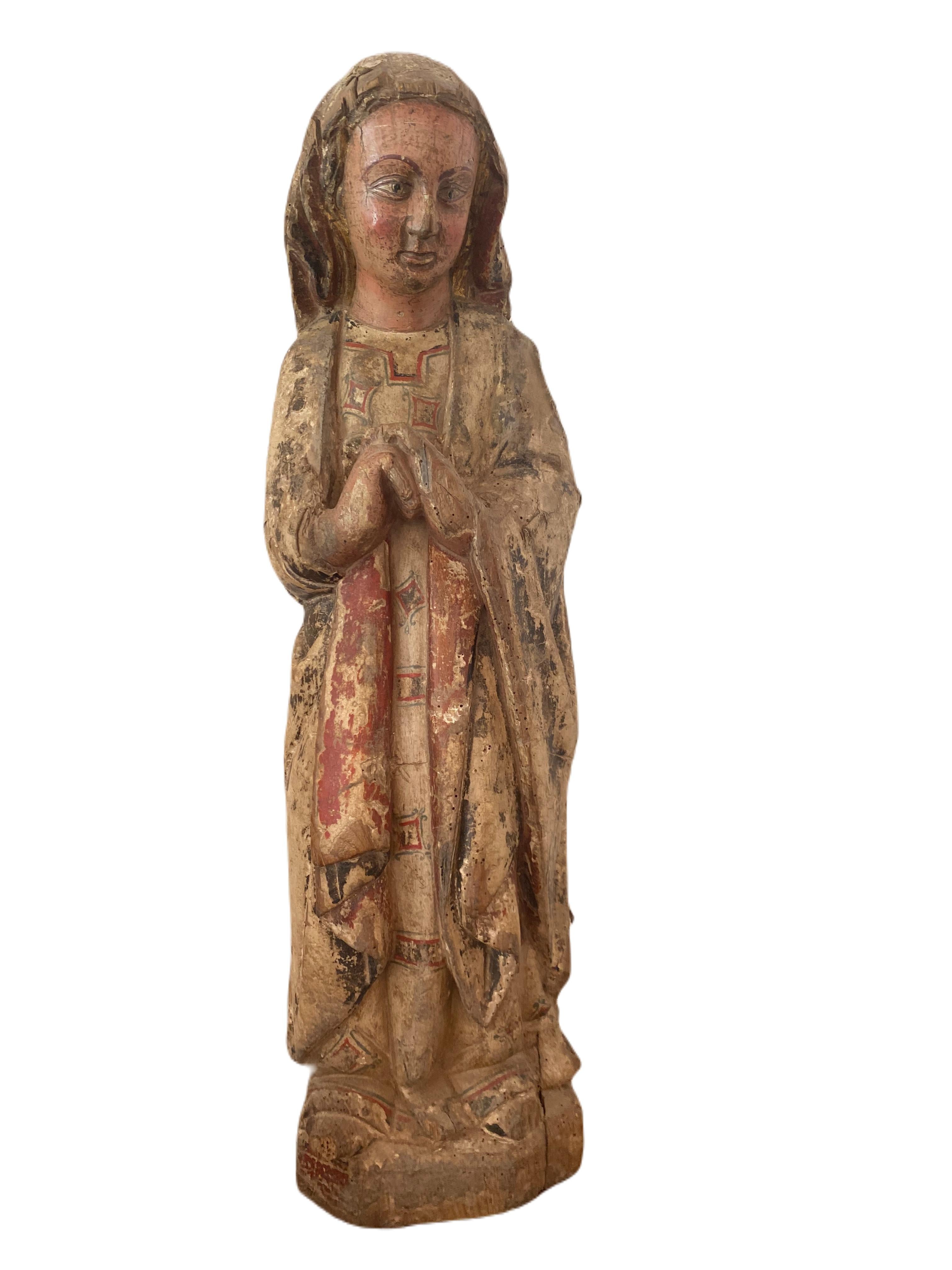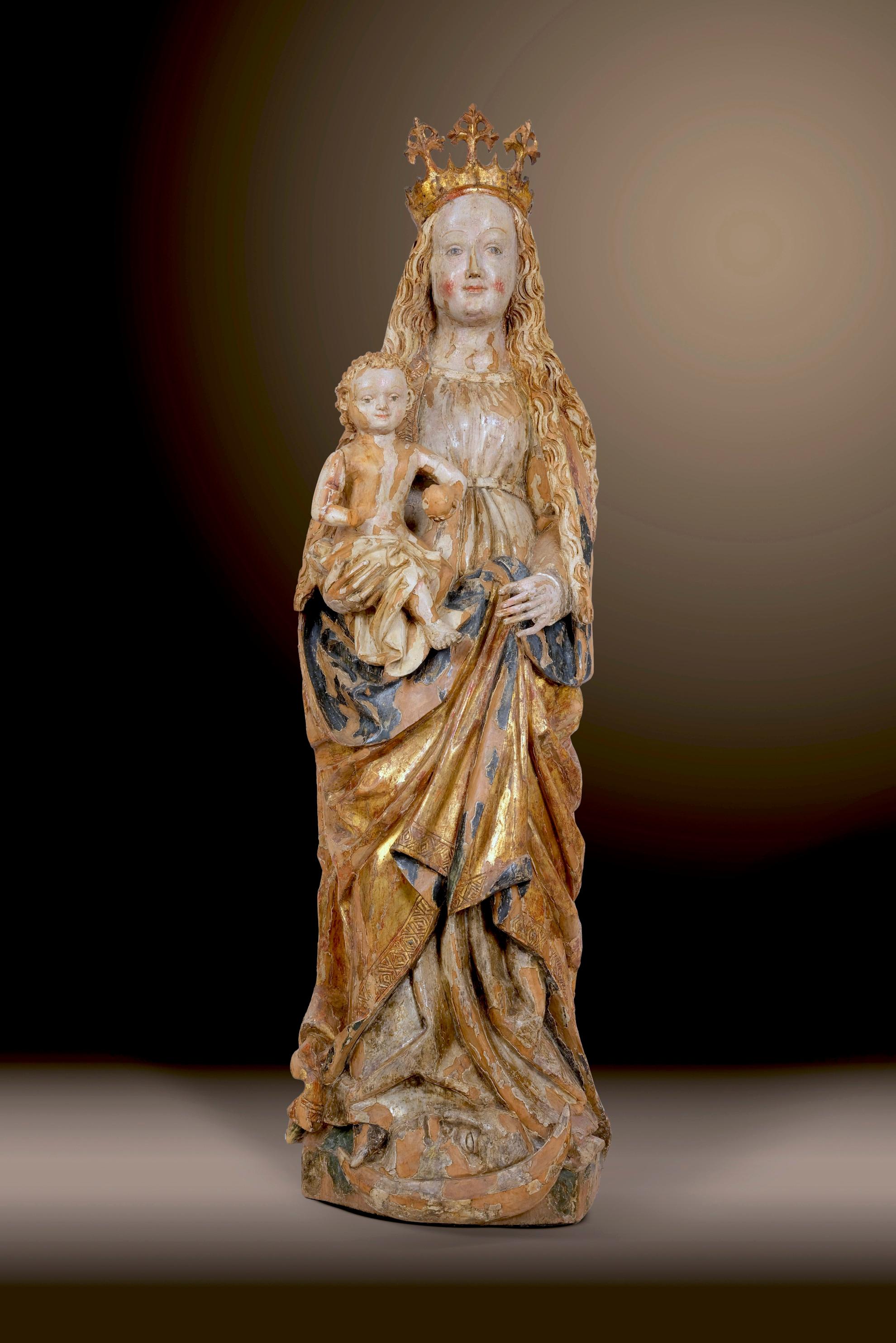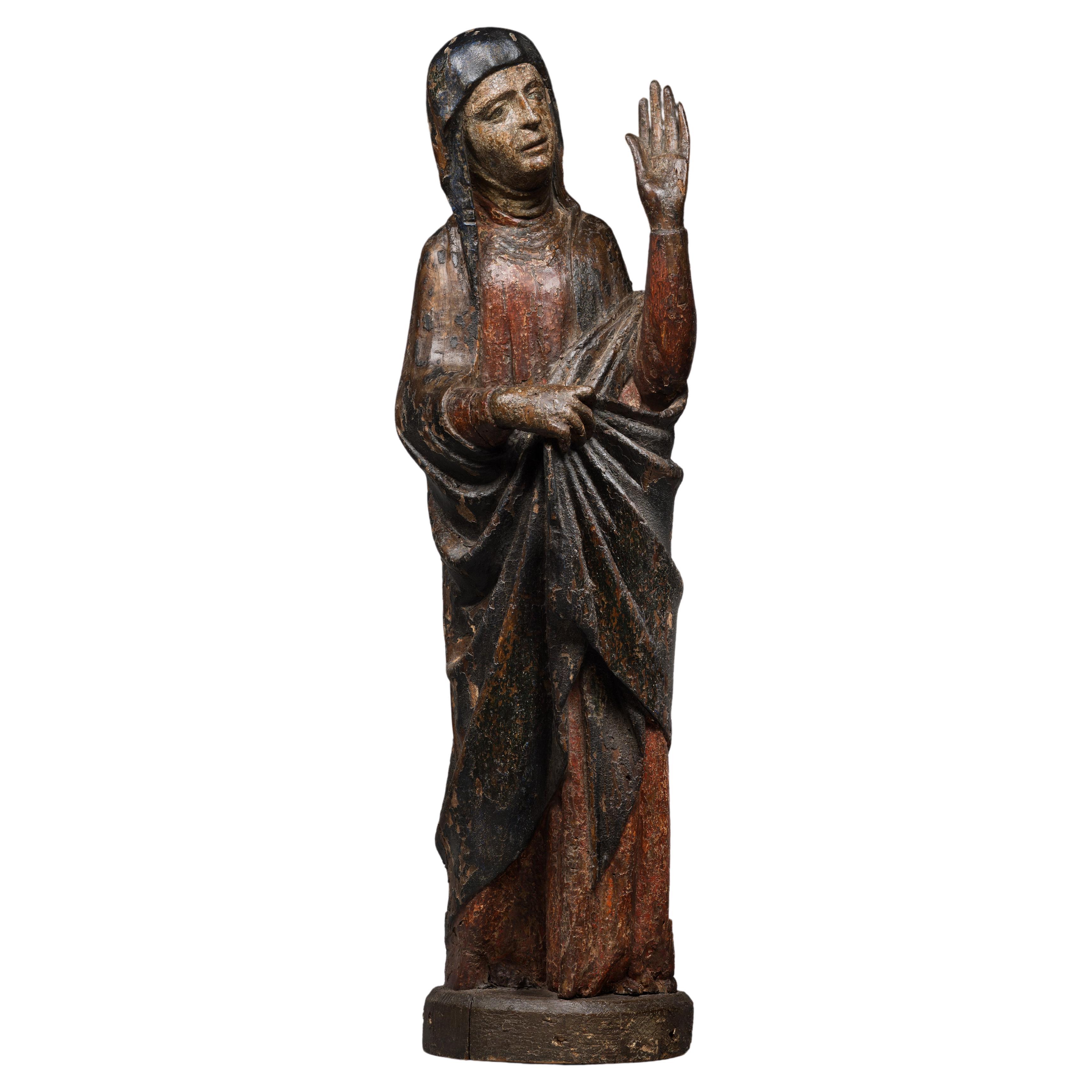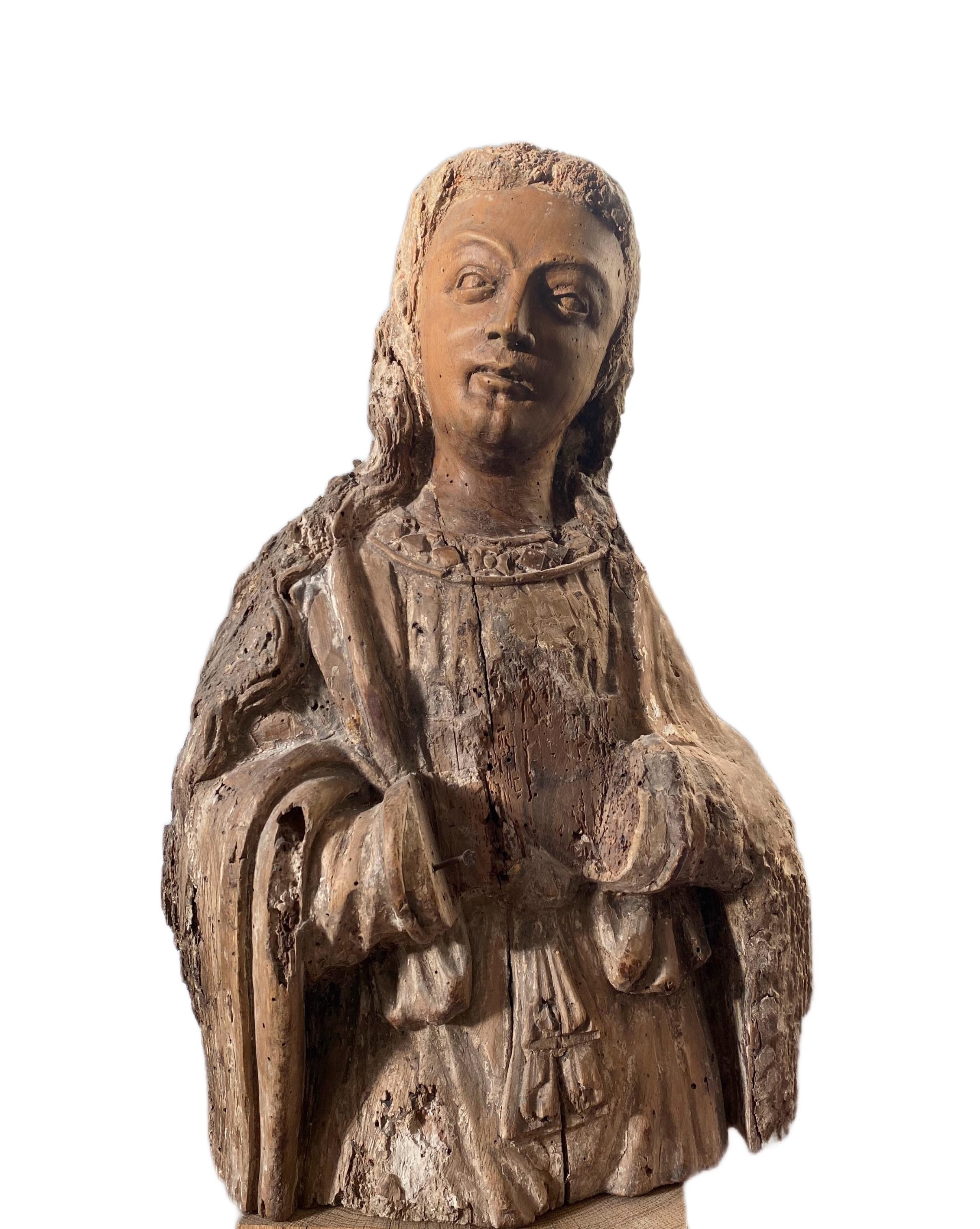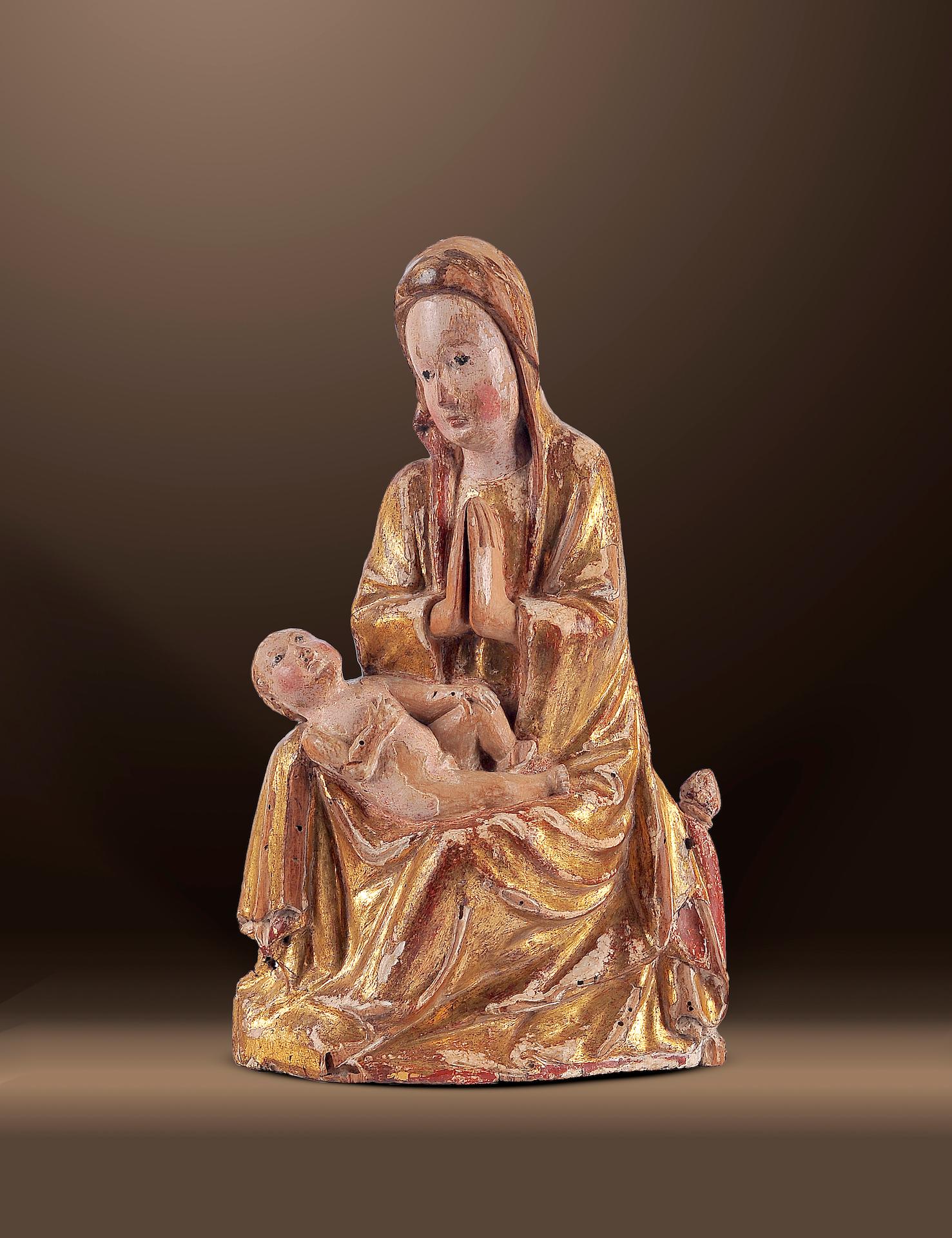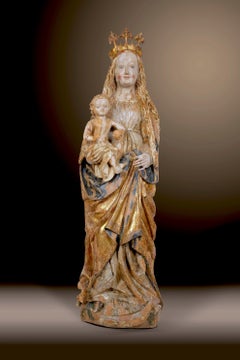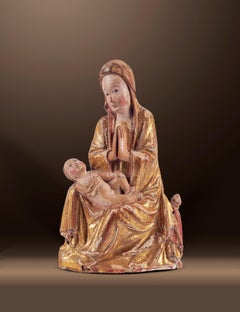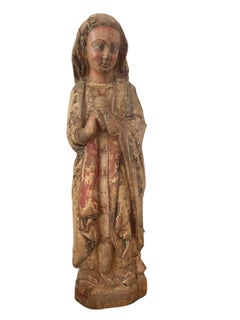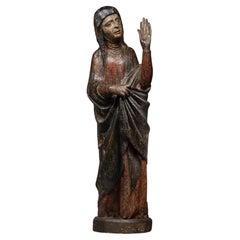Want more images or videos?
Request additional images or videos from the seller
1 of 8
Angel of the Annunciation
$168,000
£129,302.43
€147,252.56
CA$238,836.77
A$259,623.59
CHF 136,065.67
MX$3,159,840.36
NOK 1,712,741.49
SEK 1,609,419.63
DKK 1,099,683.09
About the Item
Angel of the Annunciation
Prague workshop from the circle of Master Theoderich
(mentioned from 1359 to 1368)
Around 1380/90
Carved & polychrome painted limewood
Height 88 cm
An angel of the Annunciation – a masterpiece of Gothic sculpture in the Prague area
This impressive sculpture of an angel of the Annunciation is an outstanding example of Gothic museum art. It was created around 1380/90 in the circle of Master Theoderich in Prague – one of the leading artistic centers in Central Europe at the time – and is an extremely rare piece. Their art-historical significance lies not only in their masterful execution, but also in their association with one of the most fascinating workshops of late medieval art.
Master Theoderich and his artistic environment
Master Theoderich was a key figure in the Gothic art movement in Prague in the 14th century. As court painter to Emperor Charles IV, he had a decisive influence on the artistic decoration of St. Vitus Cathedral at Prague Castle. His influence extended far beyond panel painting: Theoderich’s workshop was most likely a lively center of collaborative creativity in which painters, sculptors and artisans worked closely together. It is quite conceivable that sculptors from his school also contributed to the architectural and sculptural masterpieces that defined the sacred and imperial representation of Prague.
The angel of annunciation in detail
The sculpture shows an angel in an upright position, holding a banderole in his hands on which the words “Ave Maria” can be read. This greeting to the Virgin Mary refers to the biblical scene of the Annunciation (Luke 1:28) and identifies the figure as a supernatural messenger of God – an angel announcing the birth of Christ to Mary. The angel of annunciation is the archangel Gabriel, who appears as a divine messenger in the Christian tradition. He plays his best-known role in the Annunciation scene (Luke 1:26-38): With the words “Hail Mary, gratia plena”, he greets her as God’s chosen one. Gabriel is usually depicted as a youthful, graceful angel, often with a banderole or lily as a sign of purity.
Particularly striking are the characteristic stylistic features that reveal a close connection to the art of Master Theodoric: The short curls reaching down to the ears, with the central forelock sitting above the high forehead, are inevitably reminiscent of the figures that appear in the master’s panel paintings. The finely modeled facial features – the large, round eyes, the straight nose and the delicate mouth – reflect the naturalistic portrait style that became increasingly popular in Prague artistic circles in the late 14th century. The delicately reddened cheeks give the figure additional liveliness and warmth.
A remarkable comparison can be found in the depiction of St. Vitus in a window niche of the Chapel of the Holy Cross on Karlstein. There, too, the striking section of hair with a central mop of hair can be seen, as well as in the depiction of St. Louis of France above the south portal of the same chapel. The artistic design of the hair in thick, voluminous curls is a typical feature of Prague art from this period – impressively demonstrated by the so-called Madonna of Veveří.
The angel appears here as a youthful yet contemplative figure – a symbol of the divine message and heavenly presence. The posture and the banderole with the “Ave Maria” are clear iconographic references to his role in the Annunciation.
Garment and drapery as a reflection of Gothic fashion
The angel’s garment corresponds to the fashion trends of the late 14th century: the figure wears a simple white tunic under a long, generously draped cloak fold. The cloak is fastened with a striking clasp below the neck, which may once have been decorated with precious stones – an indication of its supernatural origin and sublime function. The powerful folds of the coat – from angular to softly curved bowl folds – testify to the sculptor’s masterful ability to bring movement and materiality to life. Particularly striking are the so-called “doughy” draperies, which characterize the “soft” or “international” style that flourished in Prague around 1400.
The Prague context – center of Gothic art
This sculpture fits into the stylistic development of angel depictions in the late Middle Ages: From earlier, often static, uniform forms to more individual and expressive figure images. The carefully designed clothing, the emphatically expressive facial features and the sculptural elaboration of the folds of the robe reflect the innovative power associated with Master Theoderic’s workshop environment.
Prague experienced an artistic heyday under the patronage of Emperor Charles IV. The city advanced to become a center of Gothic art, in which religious works not only served devotional purposes, but also underscored Prague’s growing claim to be a cultural and political metropolis. The close intertwining of piety, claim to power and artistic expression can be seen impressively in works such as this sculpture.
It is conceivable that the angel figure was created as part of the ambitious artistic aspirations of the Prague court – as part of a comprehensive program to stage the city as the new “Rome of the North”. Theoderich’s workshop played a central role in these efforts: with its high-quality devotional paintings and sculptures, it left a lasting mark on Prague’s sacred landscape. The Annunciation Angel with the banderole inscription “Ave Maria” fits perfectly into this context, in which imperial power, religious devotion and artistic innovation were closely linked.
Literature
Jiří Fajt & Jan Royt, Magister Theodoricus. The court painter of Emperor Charles IV. The artistic decoration of the sacral rooms at Karlštejn Castle, Prague 1997.
Gustav E. Pazaurek, “Theoderich”, in: Allgemeine Deutsche Biographie 37, Leipzig 1894, pp. 708-710.
- Dimensions:Height: 34.65 in (88 cm)Width: 11.82 in (30 cm)
- Medium:
- Movement & Style:
- Circle Of:Master Theoderich (Czech)
- Period:
- Condition:
- Gallery Location:Wien, AT
- Reference Number:1stDibs: LU1143216293462
About the Seller
No Reviews Yet
Vetted Professional Seller
Every seller passes strict standards for authenticity and reliability
Established in 1986
1stDibs seller since 2019
- ShippingRetrieving quote...Shipping from: Wien, Austria
- Return Policy
Authenticity Guarantee
In the unlikely event there’s an issue with an item’s authenticity, contact us within 1 year for a full refund. DetailsMoney-Back Guarantee
If your item is not as described, is damaged in transit, or does not arrive, contact us within 7 days for a full refund. Details24-Hour Cancellation
You have a 24-hour grace period in which to reconsider your purchase, with no questions asked.Vetted Professional Sellers
Our world-class sellers must adhere to strict standards for service and quality, maintaining the integrity of our listings.Price-Match Guarantee
If you find that a seller listed the same item for a lower price elsewhere, we’ll match it.Trusted Global Delivery
Our best-in-class carrier network provides specialized shipping options worldwide, including custom delivery.More From This Seller
View AllCRESCENT MOON MADONNA
Located in Wien, Wien
Master in the circle of Michael Pacher
(Mühlen ca. 1435 - 1498 Salzburg)
Salzburg
Around 1480
Carved limewood
Old polychrome version
Height 118 cm
This Madonna is an outstanding ex...
Category
15th Century and Earlier Gothic Figurative Sculptures
Materials
Wood
$168,000
Romanesque Madonna - 1175/80
Located in Wien, Wien
ROMAN MADONNA
“Sedes Sapientiae”
Auvergne
Around 1175/80
Pine wood
Polychrome remains
Height 40 cm
This depiction of the Madonna is a masterfully carved, extremely early figure made...
Category
15th Century and Earlier Gothic Figurative Sculptures
Materials
Wood
Sitting Madonna
Located in Wien, Wien
Sitting Madonna
Central Italy/Tuscany or Marche
Around 1420
Poplar wood carved
Original version
Height 31 cm
Charming Madonna sculpture from the heyday of the Soft or International...
Category
15th Century and Earlier Gothic Figurative Sculptures
Materials
Wood
Master Angel
Located in Wien, Wien
MASTER ANGEL
Museum sculpture of the master of Mauer
Austrian Danube Region
Around 1500/20
Lime wood, carved full round
Height 55 cm
Provenance:
Hofstätter Collection, Vienna
The masterful sculpture was made in the workshop of the master of the altar of Mauer around 1500 in Lower Austria. It can be located in the context of the Danube school of the first third of the 16th century, was carved from limewood and is 55 cm tall. Since there are no attributes or context, it is an unknown figure of a carved altar.
The master of the altar of Mauer is an anonymous Gothic carver who was active between 1500 and 1525 and received this so-called emergency name through the altar for the parish and pilgrimage church of Mauer near Melk. This winged altar was probably commissioned by Göttweig Abbey in the 1470s and is made of lime wood. It shows an expression in the transition from late Gothic to early Renaissance and is considered the most important carved altar in Lower Austria, created between 1510-15.
The figure presented here is very related in its design to the figures of the altar of Mauer. In lively-moving form, the male figure turns his upper body to the right, with his head pointing upward, probably toward the sky. The right leg in lunge emerges from under the frock...
Category
16th Century Figurative Sculptures
Materials
Wood
Sedes Sapientiae
Located in Wien, Wien
Sedes Sapientiae
Pustertal um 1220/30
Weichholz/Lindenholz(?)geschnitzt
Reste von originaler Polychromie
Höhe 57 cm
Category
15th Century and Earlier Figurative Sculptures
Materials
Wood
Standing Engel
Located in Wien, Wien
Standing angel with banner
Flemish
Around 1450/60
Sandstone
60 x 21 x 15 cm
This museum figurine shows a standing angel with a banner in his right hand and a small box in his left. The youthful, ageless figure wears a coat held together with a triangular, floral brooch in front of the chest over a long robe. The angel’s gaze is directed forward, his head tilted slightly to the left. The elongated face is sculpted: the large almond-shaped eyes with accentuated upper and lower eyelids are alertly open and sharp eyebrows lead directly into the root of the nose. The straight nose above the pronounced mouth completes the idealized oval face of the angel and his calm, internalized facial expression. What is particularly remarkable, however, is the magnificent curls, which are only partially tamed by a simple headband. As if puffed up by the wind, the hair, which is sometimes streaked in parallel, sometimes wildly twisted and richly curled, stands out dynamically from the ears. The tilted head with these sideways protruding waves of hair thus conveys an immediate impression of movement. The physicality of the sculpture is expressed particularly through this organic, lifelike movement of the loosened hair.
The lively overall impression of the figure is further enhanced by the multiple rolled banners that the angel presents to the viewer. The outstretched palm of the right hand appears both intimate and confidential as well as mystically revealing. This banderole winds in gentle curves in front of the figure’s body, throws a fold over the second attribute in the angel’s left hand and falls downwards in a loose manner. The volute-shaped rolled up end of the banner clearly shows the fine texture of the banner and at the same time draws the viewer’s attention to the small cube-shaped box that the angel is holding in its slender, long-limbed fingers. The cube is decorated with a Gothic quatrefoil motif, which is often seen in the architectural tracery of windows, but was also often used to decorate caskets and other small treasures. The sweeping gestures in the presentation of the attributes suggest three-dimensionality, in contrast to the tubular folds at the base of the neck and the intricate draperies in flat and multiple overlapping garment sections. The soft curves of the folds give the impression that the clothing is made of a heavy fabric that falls diagonally down the front and is laid in several bowl folds under the right hand.
Overall, the sculptural work testifies to the highest artistic skill, which emphasizes the virtuosity of sculpture in its precious and representative overall impression. The memorable characteristics recognizable here can be seen in comparable pictorial works from Utrecht around the middle of the 15th century, when sculptural art – especially stone sculpture – was characterized by a remarkably high quality. Particularly noteworthy is the accentuated Utrecht head type with an elongated oval face, almond-shaped eyes with heavy lids and dense, vividly protruding tufts of hair framing the head. For example, the figure is comparable to a capital of an angel on the east side of the rood screen of the Joriskerk in Amersfoort (province of Utrecht) from the second quarter of the 15th century. Not only the physiognomy and hair, which in the comparative example stand somewhat more horizontally to one side, but also the garment puff above the girdle are similar. Even more related motifs, such as the cleverly placed bowl folds, can be found on the limestone figure...
Category
15th Century and Earlier Figurative Sculptures
Materials
Sandstone
You May Also Like
Polychrome Virgin of the Annunciation - Catalonia
Located in PARIS, FR
Large catalan Virgin of the Annunciation in polychrome wood. Our Virgin is represented in the phase of the Conturbatio, Mary expresses her amazement a...
Category
15th Century and Earlier Gothic Figurative Sculptures
Materials
Wood
Virgin of Calvary
Located in Saint-Ouen, FR
VIRGIN OF CALVARY
ORIGIN : ITALY
PERIOD : SECOND HALF 13th CENTURY
Height : 75 cm
Length : 19 cm
Depth : 13 cm
Polychrome wood carved in the round
This rare sculpture of a Virgin of Calvary originally belonged to an ensemble depicting the Crucifixion. The Virgin would be accompanied by a sculpture of the apostle John, both flanking the Christ. Depictions of Joseph of Arimathea and Nicodemus could complete the ensemble.
The portrayal of the Descent from the Cross had to be a touching and moving scene for the viewer. Quite rare during the 10th and 11th centuries this particular scene of the Passion was very much in favour during the 12th century before other scenes took over in turn.
Mary is standing with her head slightly tilted to her right shoulder. In a gesture of intercession she raises her left hand – note the long and delicate fingers – towards the missing Christ while with her right hand she holds her cloak around her elbow. Those calm and restrained movements break with the hieratism of Romanesque sculpture...
Category
Antique 15th Century and Earlier Figurative Sculptures
Materials
Wood
$47,391
Gothic Renaissance wooden sculpture: bust of a young Saint or Angel
Located in Norwich, GB
This young saint or angel has suffered over the centuries, but his spirit has not been broken - and miraculously, his beautiful face has remained intact. With a gentle face and an al...
Category
15th Century and Earlier Gothic Figurative Sculptures
Materials
Wood
Spanish Carving of Saint John the Evangelist, School of Juan de Ancheta
By Spanish Manufactory
Located in Valladolid, ES
Outstanding Spanish carving of San Juanito, 16th century, school of Juan de Ancheta.
Juan de Ancheta (1533 - November 30, 1588) was a Spanish sculptor in the Romanesque style. His w...
Category
Antique 16th Century Spanish Renaissance Religious Items
Materials
Gold
$8,435 Sale Price
20% Off
Baroque Italian master - 17/18th century figure sculpture - Saint
Located in Varmo, IT
Carved and painted wooden sculpture - Figure of a saint - Italy, 17th-18th century.
36 x 25 x 74 cm.
Made entirely of carved, lacquered, and painted wood. Some signs of wear and pa...
Category
Late 17th Century Baroque Figurative Sculptures
Materials
Wood, Paint
$2,961 Sale Price
28% Off
Wood Sculpture Depicting John the Baptist
Located in Saint-Ouen, FR
This wood scultpure showing fine traces of polychromy depicts John the Baptist, one the Old Testament’s last prophets and the first martyr of the New Testament. He is easily recognizable with the lamb he is carrying in his left hand. The way the artist has carved the face exudes a spiritual strenght inherited from previous centuries.
Description
Saint John the Baptist is depicted bare feet, seated in a hieratic manner. His elongated face is marked by a beard and a moustache. The straight nose and wide eyes indicate a Spanish origin. This asumption is reaffirmed by the Saint’s resigned expression.
His parted hair frames his face while uncovering his ears.
He wears a round collar red-orange tunic, draped onto the body and belted at the waist. A flap of his green coat covers his knees and falls down in stylized pleats.
Following iconographic rules Saint John the Baptist is pointing with his right hand the lamb seated...
Category
Antique 15th Century and Earlier Spanish Gothic Figurative Sculptures
Materials
Wood
